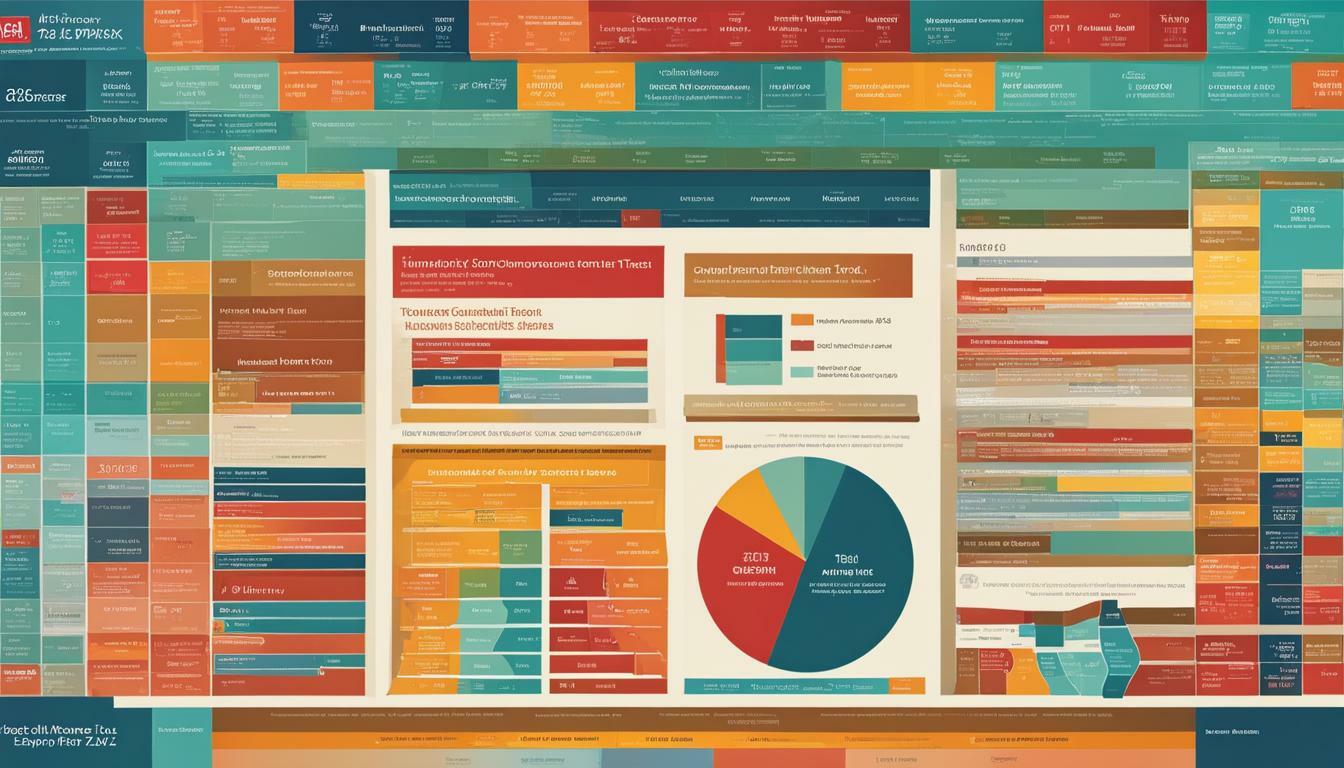Welcome to our comprehensive guide on understanding self-employment tax in 2015. If you are self-employed or considering venturing into self-employment, it’s crucial to have a clear understanding of your tax obligations. The self-employment tax is a significant aspect to consider. This article will break down the key information you need to know.
Key Takeaways:
- The self-employment tax rate for 2015 is 15.3% of net earnings from self-employment.
- Schedule SE of IRS Form 1040 is used to calculate self-employment tax.
- The maximum amount of self-employment income subject to social security tax in 2015 is $118,500.
- An additional 0.9% Medicare tax applies to net self-employment earnings over $200,000.
- Understanding self-employment tax is essential for proper financial planning and compliance with IRS regulations.
Now, let’s delve into the details of self-employment tax in 2015. Starting with what it is and why it matters for self-employed individuals in the United States.
Table of Contents
What is Self-Employment Tax?
Self-employment tax is imposed on individuals who work for themselves. It is an important consideration for those who are self-employed in 2015. It is a combination of Social Security and Medicare taxes, which are typically withheld from the paychecks of employees. However, when you are self-employed, you are responsible for paying both the employer and employee portions of these taxes.
The self-employment tax rate for 2015 is 15.3%. This tax applies to your net earnings from self-employment, which is calculated using Schedule SE of IRS Form 1040. It is important to note that the self-employment tax is in addition to any federal income tax you may owe. To determine your self-employment tax liability. You will have to calculate your net self-employment income and multiply it by the applicable tax rate.
If you are self-employed in 2015, there are a few specific details you need to be aware of. The maximum amount of self-employment income subject to social security tax is $118,500. This means that any income above this threshold is not subject to social security tax. However, all self-employment income is subject to the Medicare tax portion of the self-employment tax. Additionally, if you make over $200,000 in net self-employment earnings, an additional 0.9% Medicare tax applies.
Understanding the self-employment tax is essential for anyone who is self-employed in 2015. By accurately calculating your self-employment tax liability, you can ensure that you are meeting your tax obligations. Additionally, staying informed about any relevant deductions and thresholds is essential for effectively managing your finances as a self-employed individual.
How to Calculate Self-Employment Tax
Calculating your self-employment tax for 2015 can be done by following a simple process and utilizing the self-employment tax calculator. The self-employment tax rate for 2015 is 15.3%, which consists of 12.4% for social security tax and 2.9% for Medicare tax. To calculate your self-employment tax, you’ll need to determine your net earnings from self-employment.
To calculate net earnings from self-employment, start with your total self-employment income and subtract any allowable deductions. This includes expenses related to your business, such as supplies, equipment, and transportation costs. Once you have your net earnings, you can use Schedule SE of IRS Form 1040 to calculate your self-employment tax.
Steps to Calculate Your Self-Employment Tax:
- Determine your net earnings from self-employment
- Multiply your net earnings by 92.35% to calculate your self-employment income
- Multiply your self-employment income by 15.3% to calculate your self-employment tax
It’s important to note that the maximum amount of self-employment income subject to social security tax in 2015 is $118,500. Any earnings beyond this threshold are not subject to social security tax. Additionally, if you make over $200,000 in net self-employment earnings, an additional 0.9% Medicare tax applies.
By using the self-employment tax calculator and understanding the applicable tax rate, you can easily calculate your self-employment tax for 2015. Make sure to keep accurate records of your income and expenses to ensure accurate calculations and compliance with IRS regulations.
Deductions for Self-Employment Tax
Understanding the deductions available for self-employment tax purposes in 2015 can significantly impact your overall tax liability as a self-employed individual. These deductions can help reduce your taxable self-employment income, thereby lowering the amount of self-employment tax you owe. Here are some of the key deductions you may be eligible for:
- Business Expenses: You can deduct ordinary and necessary expenses associated with running your business. This includes expenses such as office rent, utilities, supplies, and professional fees.
- Home Office Deduction: Using a part of your home exclusively for your business makes you eligible for a deduction on expenses. This can include a portion of your rent or mortgage interest, property taxes, and utilities.
- Health Insurance Premiums: If you are self-employed and pay for your own health insurance, you may be able to deduct the premiums you paid for yourself, your spouse, and your dependents. This deduction can help offset the cost of insurance.
- Self-Employed Retirement Contributions: As a self-employed individual, you have the opportunity to contribute to retirement plans. These plans are specifically designed for the self-employed, such as a Simplified Employee Pension (SEP) IRA or a solo 401(k). Contributions to these plans are tax-deductible and can help you save for the future while reducing your current tax liability.
When claiming deductions for self-employment tax purposes. It’s important to keep detailed records and maintain proper documentation to support your deductions. This includes keeping receipts, invoices, and other relevant documents that demonstrate the business purpose of the expenses claimed.
Please note that the above deductions are not exhaustive, and there may be additional deductions you could potentially qualify for. Consulting a tax professional or utilizing tax software can help ensure you take advantage of all available deductions and maximize your tax savings.
How to File Self-Employment Tax
Filing your self-employment tax correctly and on time in 2015 is essential to avoid penalties and maintain compliance with the IRS. Here are some important steps to follow:
- Gather your information: Before you start filing your self-employment tax, make sure you have all the necessary information ready. This includes your income and expenses related to your self-employment, such as invoices, receipts, and bank statements.
- Complete Schedule C or Schedule C-EZ: Schedule C is the form you need to report your self-employment income and expenses. If you meet certain criteria, you may be eligible to use the simplified version, Schedule C-EZ. Review the instructions provided by the IRS to determine which form is right for you.
- Calculate your self-employment tax: Use Schedule SE to calculate the amount of self-employment tax you owe. The self-employment tax rate for 2015 is 15.3% of your net earnings from self-employment. This tax includes both the Social Security and Medicare taxes.
- Complete Form 1040: Transfer the information from your Schedule C or Schedule C-EZ to Form 1040, along with any other income or deductions you may have. This is the main tax return form that you need to submit.
- Pay your self-employment tax: When filing your tax return, you’ll need to include payment for the self-employment tax you owe. Make sure to use the appropriate payment method accepted by the IRS, such as electronic payment or check.
The 2015 self-employment tax due date is typically April 15th but can be extended if it falls on a weekend or holiday. Verify the deadline on the IRS website or consult a tax professional. For help with self-employment tax, consider using specialized tax software or consulting a tax professional to ensure accurate and error-free filing.
The threshold for Self-Employment Tax in 2015
The self-employment tax threshold determines when individuals need to start paying self-employment tax in 2015. This tax is applied to net earnings from self-employment and is calculated using Schedule SE of IRS Form 1040. It is important to understand this threshold as it determines your tax obligations as a self-employed individual in the United States.
For the year 2015, the self-employment tax rate is 15.3%. This includes the 12.4% for social security tax and 2.9% for Medicare tax. However, it’s worth noting that the social security tax is only applicable up to a certain income threshold. In 2015, the maximum amount of self-employment income subject to social security tax was $118,500.
Additionally, if you make over $200,000 in net self-employment earnings, an additional 0.9% Medicare tax applies. This higher Medicare tax is part of the Affordable Care Act and is used to help fund Medicare for individuals with higher incomes.
Understanding the threshold for self-employment tax in 2015 is crucial for self-employed individuals to accurately calculate their tax liability. It’s important to consult with a tax professional to ensure compliance with IRS regulations and to take advantage of available deductions or credits. Which ultimately minimizes your self-employment tax burden.
Additional Medicare Tax for High Earners
High-earning self-employed individuals in 2015 may be subject to an additional Medicare tax due to their net self-employment earnings. This tax, known as the Additional Medicare Tax, applies to individuals who earn above a certain threshold. For those filing as single, the threshold is $200,000. For married individuals filing jointly, the threshold is $250,000. And for those married but filing separately, the threshold is $125,000.
The Additional Medicare Tax rate is 0.9% and is in addition to the regular Medicare tax of 1.45%. This means that high earners who exceed the threshold will have a total Medicare tax rate of 2.35% on their net self-employment earnings. It’s important to note that the Additional Medicare Tax only applies to the income that exceeds the threshold, not the entire net self-employment earnings.
To calculate the Additional Medicare Tax owed, individuals should refer to IRS Form 8959, which is used specifically for this purpose. This form helps people figure out if they owe more tax or if they can get a credit for excess tax payments. It’s crucial for high earners to accurately calculate their net self-employment earnings. This is necessary in order to fulfill their tax obligations.
Key Points:
- High-earning self-employed individuals in 2015 may be subject to an additional Medicare tax if their net self-employment earnings exceed certain thresholds.
- The threshold for single filers is $200,000, while for married filing jointly it is $250,000, and for married filing separately it is $125,000.
- The Additional Medicare Tax rate is 0.9%, resulting in a total Medicare tax rate of 2.35% on net self-employment earnings that exceed the threshold.
- Proper calculation and reporting of net self-employment earnings is essential to fulfill tax obligations and avoid penalties.
- Tip: It’s always advisable for high earners to consult with a tax professional or use reliable tax software to ensure accurate reporting and compliance with IRS regulations.
- Reminder: The self-employment tax rate for 2015 is 15.3%, and the maximum amount of self-employment income subject to social security tax is $118,500.
Social Security Tax Limits for 2015
The maximum income subject to social security tax in 2015 sets a limit on the self-employment income that is taxable for social security purposes. For that year, the maximum amount of self-employment income subject to Social Security tax is $118,500, meaning that any self-employment income above that threshold is not subject to Social Security tax.
This limit is important for self-employed individuals to be aware of, as it determines the amount of self-employment income that is subject to social security tax. If your self-employment income exceeds $118,500 in 2015, you will only be required to pay social security tax on the first $118,500 of your earnings.
It’s worth noting that the self-employment tax rate for 2015 is 15.3%, which includes both the Social Security tax and the Medicare tax. However, if you make over $200,000 ($250,000 for married filing joint and $125,000 for married filing separately) in net self-employment earnings, an additional 0.9% Medicare tax applies.
Summary:
- The maximum income subject to social security tax in 2015 is $118,500.
- Self-employment income above this threshold is not subject to social security tax.
- The self-employment tax rate for 2015 is 15.3%.
- If you earn over $200,000 ($250,000 for married filing joint and $125,000 for married filing separately) in net self-employment earnings, an additional 0.9% Medicare tax applies.
Important Factors for Self-Employment Tax in 2015
Beyond the specific tax rates and thresholds, there are several key considerations that self-employed individuals should be aware of when it comes to their self-employment tax in 2015.
1. Recordkeeping: Keeping accurate and detailed records of your income and expenses is crucial for calculating your self-employment tax accurately. It is advisable to maintain organized financial records throughout the year to make the tax filing process smoother and minimize errors.
2. Estimated Tax Payments: Unlike employees who have taxes withheld from their paychecks, self-employed individuals are responsible for paying their taxes directly to the IRS. It is important to estimate your tax liability and make quarterly estimated tax payments to avoid penalties. The IRS provides Form 1040-ES to help you calculate and pay your estimated self-employment tax.
3. Impact on Financial Planning: Self-employment tax can have a significant impact on your overall financial planning. It is essential to factor in your tax obligations when budgeting, saving, and setting financial goals. Consider consulting with a financial advisor or tax professional to develop a comprehensive financial plan that takes into account your self-employment tax.
4. Seek Professional Advice: Self-employment tax can be complex, and the rules and regulations may change from year to year. It is wise to seek professional advice from a qualified tax professional or accountant who specializes in self-employment tax. They can help you navigate the tax laws, maximize deductions, and ensure compliance with the IRS requirements.
Financial Planning with Self-Employment Tax
Proper financial planning is crucial for self-employed individuals to navigate the complexities of self-employment tax in 2015 and ensure a solid financial foundation. Managing your tax obligations effectively can help you minimize your tax liability and maximize your overall financial well-being. Here are some key considerations to keep in mind when it comes to financial planning with self-employment tax:
1. Budgeting and Cash Flow Management
Creating a budget and managing your cash flow is essential for self-employed individuals. It’s important to track your income and expenses diligently, allowing you to plan for tax payments and set aside funds accordingly. By understanding your cash flow, you can ensure that you have enough money to cover your tax obligations without impacting your day-to-day operations.
Consider using accounting software or hiring a bookkeeper to streamline your financial management. This will help you stay organized and have a clear picture of your income and expenses, making it easier to plan for your self-employment tax payments.
2. Saving for Taxes
As a self-employed individual, you are responsible for paying your own taxes, including self-employment tax. It’s essential to set aside a portion of your income throughout the year to cover your tax obligations. By saving consistently, you can avoid the stress of a large tax bill at the end of the year and ensure that you have enough funds to meet your tax requirements.
Consider opening a separate savings account dedicated to taxes. This will help you keep your tax savings separate from your regular business or personal funds, making it easier to track your progress and stay organized. Consult with a tax professional to determine the appropriate amount to save based on your income and tax rate.
3. Seeking Professional Guidance
Self-employment tax can be complex, and navigating the ever-changing tax laws and regulations can be challenging. Seeking professional guidance from a certified public accountant (CPA) or a tax professional who specializes in self-employment tax can provide you with valuable insights and ensure that you are fulfilling your tax obligations correctly.
A CPA or tax professional can help you identify deductible expenses, maximize your deductions, and minimize your self-employment tax liability. They can also advise you on estimated tax payments, ensuring that you stay compliant with IRS requirements and avoid any penalties or interest charges.
Remember, proper financial planning is an ongoing process. Revisit your budget, savings goals, and tax strategies regularly to adapt to any changes in your business or personal circumstances. By staying proactive and well-informed, you can navigate the complexities of self-employment tax in 2015 and set yourself up for long-term financial success.
Concluding Thoughts on Self-Employment Tax in 2015
Understanding and effectively managing your self-employment tax obligations in 2015 is essential for financial success as a self-employed individual in the United States. With a self-employment tax rate of 15.3%, it is important to accurately calculate and budget for this tax throughout the year. The self-employment tax applies to net earnings from self-employment and is calculated using Schedule SE of IRS Form 1040.
Consider the 2015 cap for self-employment income subject to social security tax at $118,500. Earnings beyond this trigger social security tax on only the first $118,500. Net self-employment income exceeding $200,000 ($250,000 for married filing jointly and $125,000 for married filing separately) adds a 0.9% Medicare tax. To reduce self-employment tax, explore deductions like business expenses, health insurance premiums, and retirement plan contributions. Maintain proper records and timely IRS compliance. Financial planning is essential for managing self-employment tax. Budget, save, and manage tax payments for year-round preparedness.
In conclusion, being knowledgeable about self-employment tax requirements in 2015 is essential for any self-employed individual in the United States. By understanding the tax rates, deductions, filing requirements, and other important factors, you can navigate the complexities of self-employment tax and optimize your financial success.
FAQ
How much is the self-employment tax rate for 2015?
The self-employment tax rate for 2015 is 15.3%.
What does the self-employment tax apply to?
The self-employment tax applies to net earnings from self-employment.
How is the self-employment tax calculated?
The self-employment tax is calculated using Schedule SE of IRS Form 1040.
Is there a maximum amount of self-employment income subject to social security tax in 2015?
Yes, the maximum amount of self-employment income subject to social security tax in 2015 is $118,500.
Are there any additional taxes for high earners?
Yes, if you make over $200,000 ($250,000 for married filing joint and $125,000 for married filing separately) in net self-employment earnings, an additional 0.9% Medicare tax applies.
What are the deductions available for self-employment tax in 2015?
There are various deductions available to self-employed individuals in 2015 to reduce their taxable self-employment income and self-employment tax liability.
How do I file my self-employment tax in 2015?
You need to use the required forms and adhere to the deadlines set by the IRS for filing your self-employment tax in 2015.
At what point does self-employment income become subject to self-employment tax?
Self-employment income becomes subject to self-employment tax once it exceeds the threshold set for the tax year.
How does self-employment tax impact financial planning?
Self-employment tax should be considered when planning and budgeting for your finances, ensuring you set aside funds for tax obligations and other financial goals.
What are some important factors to consider regarding self-employment tax in 2015?
Important factors to consider include recordkeeping, making estimated tax payments, and understanding the impact of self-employment tax on your overall financial planning.
In summary, what should I know about self-employment tax in 2015?
Self-employment tax in 2015 is calculated at a rate of 15.3% on net earnings from self-employment. There is a maximum amount of self-employment income subject to social security tax, and additional Medicare tax applies to high earners. It is important to understand the deductions available, file your taxes correctly, and plan your finances accordingly.




